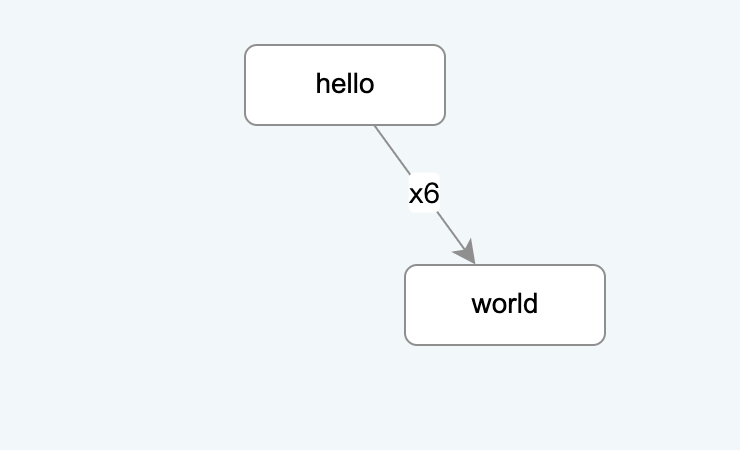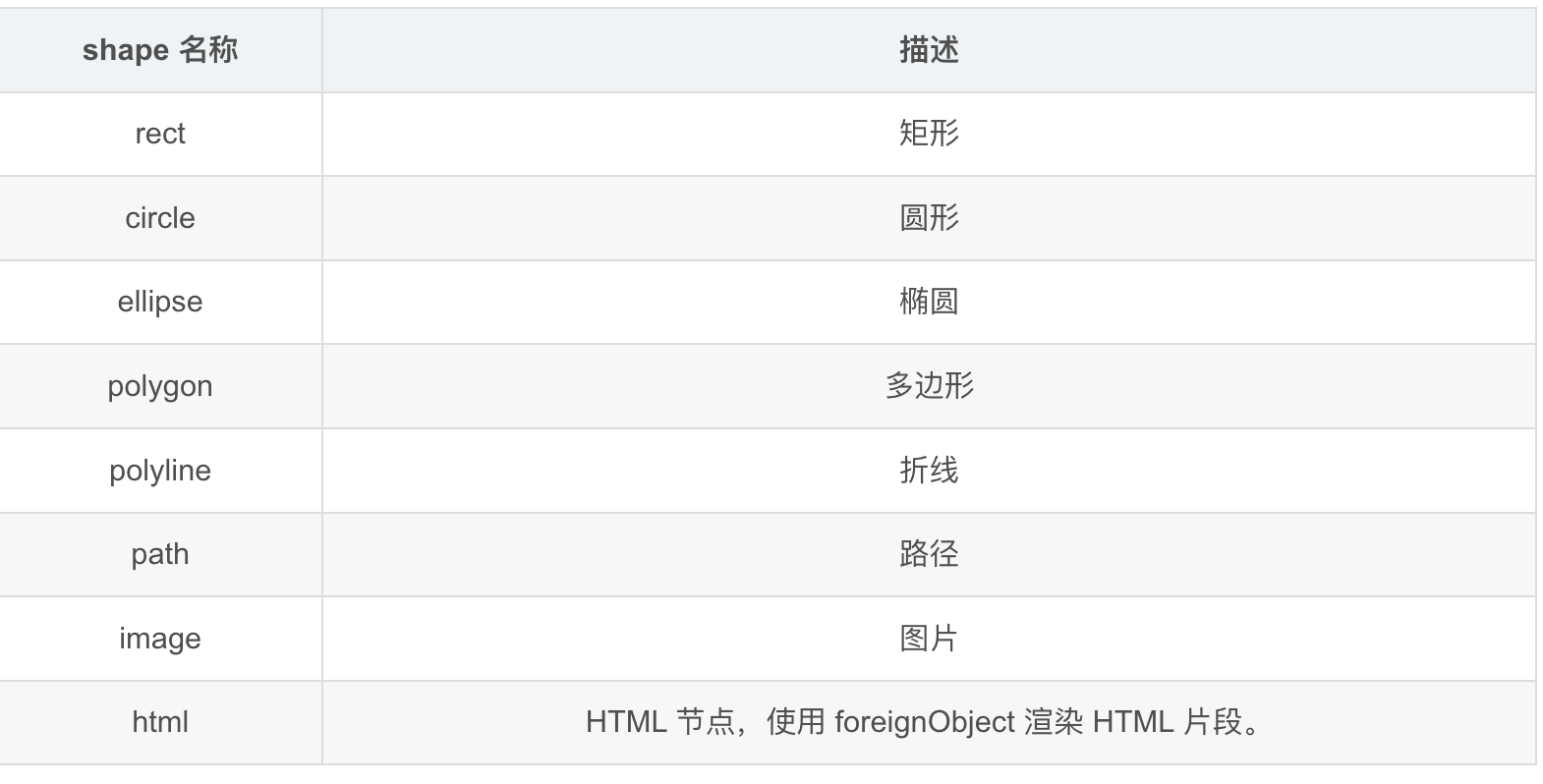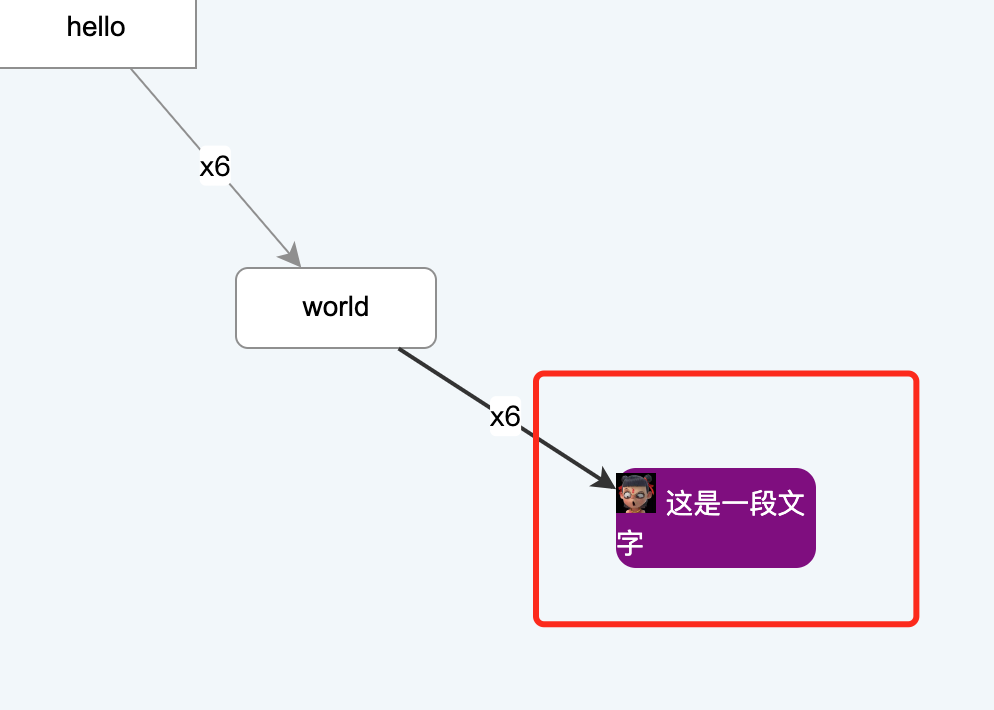vue2 antv x6 入门 (一)画布、节点、边
安装
# npm npm install @antv/x6 --save # yarn yarn add @antv/x6
1. 初始化画布
<div id="container"></div>
import { Graph } from '@antv/x6'
const graph = new Graph({
container: document.getElementById('container'),
width: 800,
height: 600,
background: {
color: '#F2F7FA',
},
})
2、渲染节点和边
X6 支持 JSON 格式数据
该对象中
nodes 代表节点数据,
edges 代表边数据,
可以使用 attrs 属性来定制节点和边的样式(可以类比 CSS)。
3、画布添加节点、边
创建data1.js文件
const data = { nodes: [ { id: 'node1', // id唯一标识 shape: 'rect', x: 40, y: 40, width: 100, height: 40, label: 'hello', attrs: { // body 是选择器名称,选中的是 rect 元素 body: { stroke: '#8f8f8f', //边的颜色 strokeWidth: 1, // 边线宽 fill: '#fff', // 背景颜色,跟选择相关,如果是文字fill代表是字体颜色 rx: 6, // 圆角弧数 ry: 6, // 圆角弧数 }, }, }, { id: 'node2', shape: 'rect', x: 160, y: 180, width: 100, height: 40, label: 'world', attrs: { body: { stroke: '#8f8f8f', strokeWidth: 1, fill: '#fff', rx: 6, ry: 6, }, }, }, ], edges: [ { shape: 'edge', source: 'node1', target: 'node2', label: 'x6', attrs: { // line 是选择器名称,选中的边的 path 元素 line: { stroke: '#8f8f8f', strokeWidth: 1, }, }, }, ], }
export default data
页面使用 json数据
graph.fromJSON(data) // 渲染元素 graph.centerContent() // 居中显示
效果

页面代码
<template>
<div>
<div id="container"></div>
</div>
</template>
<script>
import { Graph } from '@antv/x6'
import dataJSON from './data1'
export default {
name: 'index2Page',
data() {
return {
graph: null
}
},
mounted() {
this.initGraph()
},
methods: {
initGraph() {
this.graph = new Graph({
container: document.getElementById('container'),
width: 800,
height: 600,
background: {
color: '#F2F7FA'
}
})
console.log(dataJSON)
this.graph.fromJSON(dataJSON) // 渲染元素
this.graph.centerContent() // 居中显示
}
}
}
</script>
这里是重点:
X6 支持使用 SVG、HTML 来渲染节点内容,在此基础上,我们还可以使用 React、Vue 组件来渲染节点,这样在开发过程中会非常便捷。在拿到设计稿之后,你就需要权衡一下使用哪一种渲染方式,可以参考下面的一些建议:
- 如果节点内容比较简单,而且需求比较固定,使用
SVG节点 - 其他场景,都推荐使用当前项目所使用的框架来渲染节点
1、使用svg渲染节点
- 节点和边都有共同的基类 Cell,除了从 Cell 继承属性外,还支持以下选项。
| 属性名 | 类型 | 默认值 | 描述 |
|---|---|---|---|
| x | number | 0 | 节点位置 x 坐标,单位为 px |
| y | number | 0 | 节点位置 y 坐标,单位为 px |
| width | number | 1 | 节点宽度,单位为 px |
| height | number | 1 | 节点高度,单位为 px |
| angle | number | 0 | 节点旋转角度 |
graph.addNode({ shape: 'rect', x: 100, y: 40, width: 100, height: 40, })
二、内置节点
使用 shape 指定节点的图形,shape 的默认值为 rect。X6 内置节点与 shape 名称对应关系如下表

graph.addNode({ shape: "rect", x: 40, y: 40, width: 80, height: 40, label: "rect", });
三、定制节点
markup 和 attrs 来定制节点的形状和样式,markup 可以类比 HTML,attrs 类比 CSS。
Rect.config({ width: 100, height: 40, markup: [ // 定义了节点由 <rect> 和 <text> 两个 SVG 元素构成,并分别指定了 body 和 label 两个选择器,接着就可以在 attrs 中通过这两个选择器来指定节点的默认样式。 { tagName: 'rect', selector: 'body', }, { tagName: 'text', selector: 'label', }, ], attrs: { body: { fill: '#ffffff', stroke: '#333333', strokeWidth: 2, }, label: { fontSize: 14, fill: '#333333', refX: '50%', refY: '50%', textAnchor: 'middle', textVerticalAnchor: 'middle', }, }, })
四、VUE 自定义节点
npm install @antv/x6-vue-shape --save
节点Vue
<template> <div class="rounded-corner"> <div class="content"> <img :src="require('@/assets/img/4.png')" width="20" alt="" /> 这是一段文字 </div> </div> </template> <style scoped> .rounded-corner { background-color: purple; height: 50px; width: 100px; border-radius: 10px; display: flex; justify-content: center; align-items: center; } .content { color: white; font-size: 14px; } </style>
主页面 ,引入注册组件及 vue组件
import { register, getTeleport } from '@antv/x6-vue-shape'
import vueNode1 from './node1.vue'
注册节点 - 添加画布
// 注册vue组件节点 register({ shape: 'custom-vue-node', x: 200, y: 100, width: 100, height: 50, component: vueNode1 }) this.graph.addNode({ id: 'xxfdafds', shape: 'custom-vue-node', // 指定使用何种图形,默认值为 'rect' x: 200, y: 100, width: 60, height: 60 })
边线 addEdge 即可
效果:

antx6---参考官网



